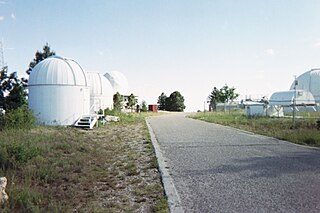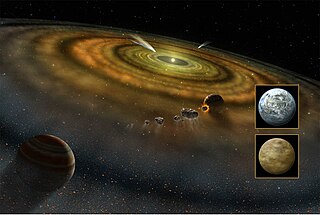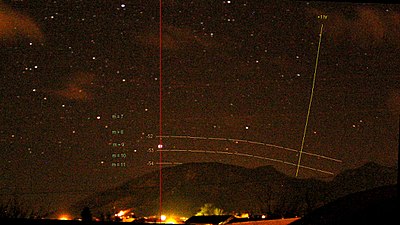
A Ritchey–Chrétien telescope is a specialized variant of the Cassegrain telescope that has a hyperbolic primary mirror and a hyperbolic secondary mirror designed to eliminate off-axis optical errors (coma). The RCT has a wider field of view free of optical errors compared to a more traditional reflecting telescope configuration. Since the mid 20th century, a majority of large professional research telescopes have been Ritchey–Chrétien configurations; some well-known examples are the Hubble Space Telescope, the Keck telescopes and the ESO Very Large Telescope.

George Willis Ritchey was an American optician and telescope maker and astronomer born at Tuppers Plains, Ohio.
Anderson Mesa Station is an astronomical observatory established in 1959 as a dark-sky observing site for Lowell Observatory. It is located at Anderson Mesa in Coconino County, Arizona (USA), about 12 miles southeast of Lowell's main campus on Mars Hill in Flagstaff, Arizona.

Mount Lemmon Observatory (MLO), also known as the Mount Lemmon Infrared Observatory, is an astronomical observatory located on Mount Lemmon in the Santa Catalina Mountains approximately 28 kilometers (17 mi) northeast of Tucson, Arizona (US). The site in the Coronado National Forest is used with special permission from the U.S. Forest Service by the University of Arizona's Steward Observatory, and contains a number of independently managed telescopes.
The United States Naval Observatory Flagstaff Station (NOFS), is an astronomical observatory near Flagstaff, Arizona, US. It is the national dark-sky observing facility under the United States Naval Observatory (USNO). NOFS and USNO combine as the Celestial Reference Frame manager for the U.S. Secretary of Defense.
Orion Telescopes & Binoculars is an American retail company that sells telescopes, binoculars and accessories online and in-store for astronomy and birdwatching. It was founded in 1975 and has corporate offices in Watsonville, California. A large proportion of its products are manufactured by the Chinese company Synta for the Orion brand name. Orion Telescopes & Binoculars ships its products to the United States and over 20 other countries. Orion puts out a semi-quarterly mail-order catalog as well as email catalogs. The company is a prominent advertiser in North American astronomy magazines, such as Sky & Telescope and Astronomy.
The Junk Bond Observatory is located in the Sonoran Desert at Sierra Vista, Arizona, United States.

The National Astronomical Observatory is an astronomical observatory in Baja California, Mexico.
Circumstellar dust is cosmic dust around a star. It can be in the form of a spherical shell or a disc, e.g. an accretion disk. Circumstellar dust can be responsible for significant extinction and is usually the source of an infrared excess for stars that have it. For some evolved stars on the asymptotic giant branch, the dust is composed of silicate emissions while others contain the presence of other dust components. According to a study, it is still uncertain whether the dust is a result of crystalline silicate or polycyclic aromatic hydrocarbon. However, recent observations revealed that Vega-type stars display broad silicate emission. It is suggested that the circumstellar dust components can depend on the evolutionary stage of a star and is related to the changes in its physical conditions.

RC Optical Systems was a high-end American telescope and optics manufacturer that specialized in Ritchey-Chrétien telescopes with hyperbolic mirrors. RC also made related mounts and systems for the telescopes, with a focus on open and closed carbon fiber trusses for low expansion. The basic Ritchey-Chrétien optical system uses two mirrors and no refracting elements, which reduces light loss and its optical characteristics make it popular for astrophotography. Refracting elements may be added to correct for field curvature.
The Dark Sky Observatory (DSO) is an astronomical observatory owned and operated by Appalachian State University (ASU). It is located 9 kilometers (5.6 mi) east of Deep Gap, North Carolina (USA), off of the Blue Ridge Parkway, and 32 kilometers (20 mi) east of the ASU campus in Boone, North Carolina It was established in 1981, and is used for research, instruction, and public viewing events. The Cline Visitors' Center was completed in 2011.

An exocomet, or extrasolar comet, is a comet outside the Solar System, which includes rogue comets and comets that orbit stars other than the Sun. The first exocomets were detected in 1987 around Beta Pictoris, a very young A-type main-sequence star. There are now a total of 27 stars around which exocomets have been observed or suspected.

A sub-Earth is a planet "substantially less massive" than Earth and Venus. In the Solar System, this category includes Mercury and Mars. Sub-Earth exoplanets are among the most difficult type to detect because their small sizes and masses produce the weakest signal. Despite the difficulty, one of the first exoplanets found was a sub-Earth around a millisecond pulsar PSR B1257+12. The smallest known is WD 1145+017 b with a size of 0.15 Earth radii, or somewhat smaller than Pluto. However, WD 1145+017 b is not massive enough to qualify as a sub-Earth classical planet and is instead defined as a minor, or dwarf, planet. It is orbiting within a thick cloud of dust and gas as chunks of itself continually break off to then spiral in towards the star, and within around 5,000 years it will have more-or-less disintegrated.

Tabby's Star is an F-type main-sequence star in the constellation Cygnus approximately 1,470 light-years from Earth. Unusual light fluctuations of the star, including up to a 22% dimming in brightness, were discovered by citizen scientists as part of the Planet Hunters project. In September 2015, astronomers and citizen scientists associated with the project posted a preprint of an article describing the data and possible interpretations. The discovery was made from data collected by the Kepler space telescope, which observed changes in the brightness of distant stars to detect exoplanets.

Tabetha "Tabby" Suzanne Boyajian is an American astronomer of Armenian descent and astrophysicist on faculty at Louisiana State University. She was a post-doctoral fellow 2012–16 at Yale University, working with Debra Fischer. Boyajian is active in the astronomical fields of stellar interferometry, stellar spectroscopy, exoplanet research, and high angular resolution astronomy, all particularly at optical and infrared wavelengths. She was the lead author of the September 2015 paper "Where's the Flux?", which investigated the highly unusual light curve of KIC 8462852; the star is colloquially known as Tabby's Star in her honor.
WD 1145+017 is a white dwarf approximately 570 light-years (170 pc) from Earth in the constellation of Virgo. It is the first white dwarf to be observed with a transiting planetary-mass object orbiting it.

UCL Observatory at Mill Hill in London is an astronomical teaching observatory. It is part of the Department of Physics and Astronomy at University College London.

In astronomy, a disrupted planet is a planet or exoplanet or, perhaps on a somewhat smaller scale, a planetary-mass object, planetesimal, moon, exomoon or asteroid that has been disrupted or destroyed by a nearby or passing astronomical body or object such as a star. Necroplanetology is the related study of such a process. Nonetheless, the result of such a disruption may be the production of excessive amounts of related gas, dust and debris, which may eventually surround the parent star in the form of a circumstellar disk or debris disk. As a consequence, the orbiting debris field may be an "uneven ring of dust", causing erratic light fluctuations in the apparent luminosity of the parent star, as may have been responsible for the oddly flickering light curves associated with the starlight observed from certain variable stars, such as that from Tabby's Star, RZ Piscium and WD 1145+017. Excessive amounts of infrared radiation may be detected from such stars, suggestive evidence in itself that dust and debris may be orbiting the stars.

WD 0145+234 is a white dwarf star approximately 95 ly (29 pc) from Earth in the constellation of Aries that has been associated with studies suggesting that a very large exoasteroid near the star was substantially disrupted, resulting in a considerable amount of dust and debris around the star. Alternatively the outburst around WD 0145+234 is explained with ongoing collisions between planetesimals inside the dusty debris disk around the white dwarf.






















